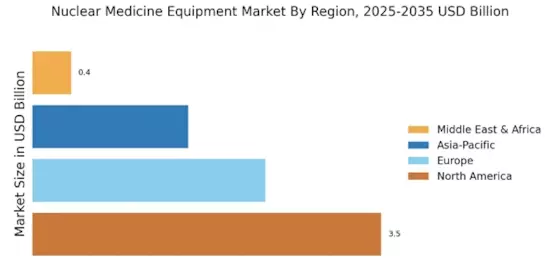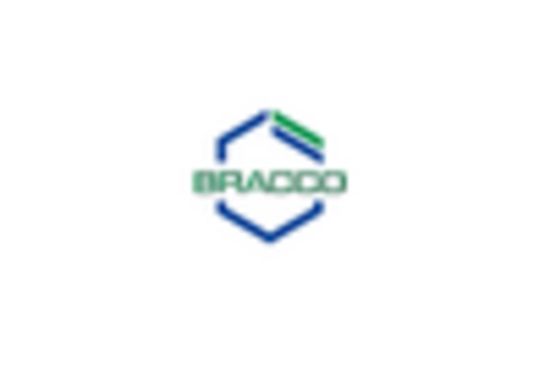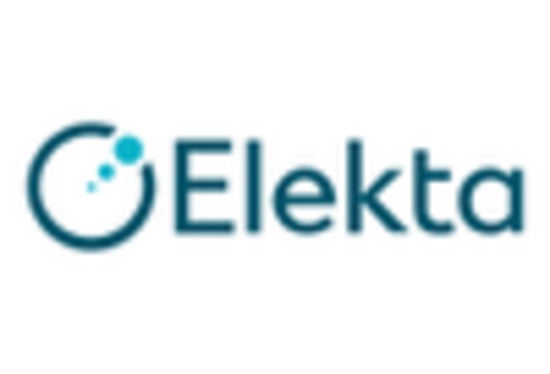Increasing Prevalence of Chronic Diseases
The rising incidence of chronic diseases such as cancer, cardiovascular disorders, and neurological conditions is a primary driver for the Nuclear Medicine Equipment Market. As these diseases become more prevalent, the demand for advanced diagnostic and therapeutic solutions increases. Nuclear medicine plays a crucial role in the early detection and treatment of these conditions, utilizing techniques such as PET and SPECT imaging. According to recent data, the market for nuclear medicine is projected to grow significantly, with an estimated compound annual growth rate of over 8% in the coming years. This growth is largely attributed to the increasing need for effective imaging modalities that can provide precise information about disease progression, thereby enhancing patient outcomes.
Growing Awareness of Nuclear Medicine Benefits
The increasing awareness of the benefits of nuclear medicine is driving growth in the Nuclear Medicine Equipment Market. Healthcare professionals and patients are becoming more informed about the advantages of nuclear imaging techniques, such as their ability to provide functional information about organs and tissues. This awareness is fostering a greater acceptance of nuclear medicine as a vital component of modern healthcare. Educational initiatives and outreach programs are playing a crucial role in disseminating information about the efficacy and safety of nuclear medicine procedures. As a result, more healthcare providers are incorporating nuclear medicine into their diagnostic and treatment protocols, leading to an uptick in demand for related equipment.
Rising Investment in Healthcare Infrastructure
The ongoing investment in healthcare infrastructure is a significant driver for the Nuclear Medicine Equipment Market. Governments and private entities are allocating substantial resources to enhance healthcare facilities, particularly in developing regions. This investment is aimed at expanding access to advanced medical technologies, including nuclear medicine equipment. As healthcare systems evolve, there is a growing emphasis on integrating nuclear medicine into routine clinical practice. This trend is reflected in the increasing number of nuclear medicine departments being established in hospitals and diagnostic centers. Consequently, the demand for nuclear medicine equipment is expected to rise, as healthcare providers strive to meet the needs of a growing patient population.
Technological Innovations in Imaging Techniques
Technological advancements in imaging techniques are transforming the Nuclear Medicine Equipment Market. Innovations such as hybrid imaging systems, which combine PET and CT or MRI, are enhancing diagnostic accuracy and patient management. These systems allow for simultaneous imaging, providing comprehensive insights into both anatomical and functional aspects of diseases. The introduction of new radiopharmaceuticals and improved detector technologies further boosts the market, as they enable more sensitive and specific imaging. The market is expected to witness a surge in demand for these advanced systems, as healthcare providers increasingly seek to adopt cutting-edge technologies to improve diagnostic capabilities and treatment planning.
Expansion of Research and Development Activities
The expansion of research and development activities in the field of nuclear medicine is a key driver for the Nuclear Medicine Equipment Market. Ongoing research efforts are focused on developing new radiopharmaceuticals and improving imaging technologies, which are essential for enhancing diagnostic accuracy and treatment efficacy. Collaborations between academic institutions, research organizations, and industry stakeholders are fostering innovation and accelerating the development of novel nuclear medicine applications. This collaborative environment is likely to result in the introduction of advanced nuclear medicine equipment that meets the evolving needs of healthcare providers. As R&D activities continue to grow, the market is expected to benefit from the introduction of cutting-edge technologies that enhance patient care.


















Leave a Comment